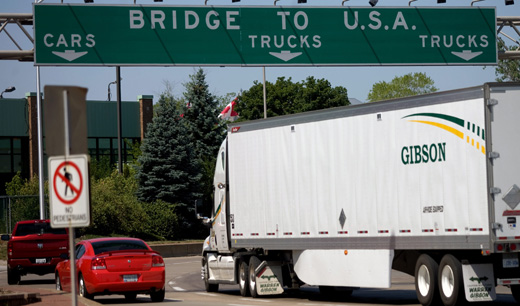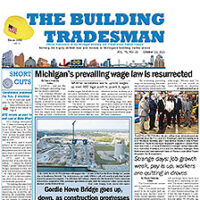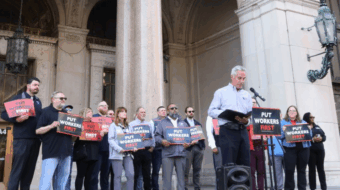
DETROIT (PAI) — A new billion-dollar bridge, and its approaches, between Detroit and Windsor, Ont., serving the busiest and most-jammed border crossing from Canada to the U.S., will create 10,000 or more new jobs, at least on the U.S. side of the border, according to top politicians and the United Steelworkers (USW).
That’s because U.S. workers will build the U.S. section of the span, once it clears legal challenges, leaders say, and because sourcing rules say U.S. and Canadian steel and other materials will be used for its superstructure, approaches, roads and the U.S. Customs plaza. Some details about Canadian materials sourcing are being worked out.
“It’s gratifying that this bridge will be built using steel and other materials made right here at home, creating jobs for Canadian and American workers,” said USW President Leo Gerard, a Canadian native.
The Canadian government will pay to build the bridge, including Michigan’s share, and recoup the money from tolls over 40-50 years after the bridge opens. Canada’s $550 million share of the $950 billion cost to erect the bridge and its approaches will be eligible for U.S. matching money from the Highway Trust Fund, whose gas tax revenues pay for roads and bridges in the U.S.
The New International Trade Crossing (NITC) will provide a modern bridge between Detroit and Windsor vital to enhancing the $70 billion-a-year in trade between Michigan and Canada. Much of that trade is between the Detroit 3 automakers and Canadian subsidiaries and suppliers.
Much U.S.-Canada trade, the nation’s largest, is Detroit to Windsor and vice versa.
“We’re thrilled the NITC is moving forward,” said Michigan Building and Construction Trades Council Secretary-Treasurer Patrick Devlin, who was at the international bridge signing on June 15. “We wish we could start tomorrow. But now at least we have a path forward to creating thousands of building trades jobs.”
To be located about two miles down the Detroit River from the current Ambassador Bridge, the new bridge will generate thousands of short- and long-term jobs on both sides of the border, strengthen Michigan as a trade conduit, strengthen economic security and ultimately ease traffic congestion.
And it’ll be built with U.S. and Canadian steel, Gerard adds.
“Today’s deal is a great victory for workers in both the United States and Canada,” said Ken Neumann, USW’s Canadian national director. “Our hard work has paid off.” Neumann lobbied Canada’s Minister of Transport, Denis Lebel, stressing the importance of sourcing the bridge’s steel in the U.S. and Canada. Gerard often talked with Obama Administration Transportation Secretary Ray LaHood on the same issue.
“This agreement is about more than building a bridge,” Snyder said. “It’s about building a future of economic strength and security for families across our entire state.
“Now that there’s a deal to build the bridge, we call on Prime Minister Harper and Ontario Premier Dalton McGuinty to clearly say the Canadian-side infrastructure will be built with Canadian jobs and materials,” said the Steelworkers’ Neumann.
A joint 6-member international authority will oversee letting of bids to privately design, develop, finance, construct and operate the bridge. The board will hire a private concessionaire to run the bridge and collect the tolls. Including land acquisition, and interstate and interchange improvements, the total project cost is estimated at $4 billion.
A broad international coalition including unions, auto firms and suppliers, the agriculture industry, manufacturers, municipal and transportation leaders, chambers of commerce, the mining industry and utility companies supported building the bridge.
The existing Detroit-Windsor bridge is the busiest trade crossing on the U.S.-Canada border, and the biggest traffic bottleneck in the Inter-American highway system. About 237,000 Michigan jobs depend on Michigan-Canada trade.
A lawsuit against the new bridge is almost certain from billionaire Matty Moroun. He owns the Ambassador Bridge, which opened in 1929. He’s also sponsored a petition drive to “let voters decide” if the state should be involved in construction of the new bridge.
Marty Mulcahy is editor of The Building Tradesman.
Photo: Motorists make their way to the old Ambassador Bridge connecting Canada to the United States in Windsor, Ontario, June 15. The long-awaited new bridge project at Canada’s busiest border crossing is expected to ease traffic gridlock and encourage trade. Mark Spowart/The Canadian Press/AP











